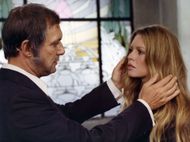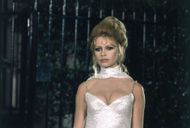According to a report from Hello!, Brigitte Bardot has spent decades in the public eye, known as much for her artistic achievements as for her romantic life. Throughout her early career, she had been linked to several co-stars and filmmakers and has been married four times.
However, the actress recently faced unusual rumors, so this week, Brigitte Bardot decided to clear up any misconceptions. She dismissed online rumors suggesting she had died. The French screen legend, now 91, stated that she was “doing well” in a post shared on X on Wednesday, October 22.
“I don’t know which idiot started this fake news about my disappearance tonight, but know that I’m fine and I have no intention of bowing out. A word to the wise,” she wrote in French.
The clarification followed reports from Var-Matin, which had noted that Bardot was recuperating at her home in Saint-Tropez after a three-week hospital stay. The newspaper said she had undergone surgery for a “serious illness” and was in a “worrying condition.” Bardot’s office later confirmed to Reuters that the actress had received “minor surgery that went well” and was recovering. Reuters added that she had thanked the medical team at the Saint-Jean Private Hospital in Toulon for their assistance.

Inside Brigitte Bardot’s four marriages: A life of love, fame, and restless passion
The First Marriage: Roger Vadim (1952–1957)
At just 18, Brigitte Bardot married director Roger Vadim in 1952. He was six years older, and together they became one of French cinema’s most talked-about couples. Before Vadim gained notoriety for his later relationships with women like Jane Fonda, Bardot was his muse. Their marriage ended in 1957, but not in bitterness. They stayed on good terms and even collaborated on projects afterward.
The Trintignant Chapter (1956–1958)
While still married, Bardot’s relationship with her And God Created Woman co-star Jean-Louis Trintignant blossomed. Their affair made headlines across Europe. Trintignant, married to actress Stéphane Audran, left his wife that same year. The pair lived together for two years before Bardot began seeing musician Gilbert Bécaud, ending the relationship in 1958.
The Second Marriage: Jacques Charrier (1959–1962)
Love found her again on the set of Babette Goes to War, where she met actor Jacques Charrier. They married in 1959 after a fast-paced courtship. Seven months later, Bardot gave birth to their son, Nicolas-Jacques, though she later admitted motherhood had not thrilled her.
Their marriage dissolved in 1962, largely due to Bardot’s affair with Glenn Ford. Charrier raised their son, while the mother and son reconnected later in life.
Life Between Loves (1963–1965)
After the divorce, Bardot shared her life with musician Bob Zagury, all while continuing her reign as one of cinema’s brightest stars.
The Third Marriage: Gunter Sachs (1966–1969)
In 1966, Bardot wed German millionaire Gunter Sachs. His grand romantic gesture, showering her villa with roses from a helicopter, seemed to promise a storybook romance. But passion, as always, proved fleeting. Days after the wedding, Bardot began an affair with singer Mike Sarne. By 1969, the marriage was over.
The Lovers and the Years (1970s–1980s)
After Sachs, Bardot’s love life continued to draw attention. She shared a relationship with actor Patrick Gilles, then went on to date Serge Gainsbourg, Christian Kalt, John Gilmore, and Warren Beatty. Her longest partnerships were with sculptor Miroslav Brozek (1975–1979), for whom she posed as a model, and television producer Allain Bougrain-Dubourg (1980–1985).
The Fourth Marriage: Bernard d’Ormale (1992–Present)
Everything changed in 1992 when Bardot met Bernard d’Ormale, a businessman and political adviser. They married within a month of meeting, and for the first time, Bardot found lasting stability. Their marriage not only endured but also helped her reconcile with her estranged son. In her memoir Larmes de combat, Bardot wrote candidly about her lifelong pursuit of passion:
“With each relationship, I would constantly go back in search of other loves when the present became lukewarm. I don't like the in-between, the less good. I have always sought passion. That is why I have often been unfaithful. And when passion was coming to an end, I would pack my bags.”
Brigitte Bardot’s beauty revolution still echoes through fashion and film:

In early 2025, Maxim noted that Brigitte Bardot seemed to be having another cultural moment. You could see her fingerprints everywhere again, on magazine covers, coffee-table books, even in the mood of new photo shoots. Sabrina Carpenter’s Vogue Italia cover, photographed by Steven Meisel, looked straight out of the 1960s. The teased hair, the soft eyeliner, that unbothered pose, pure Brigitte Bardot.
Two new art books were part of the revival. Being Bardot from ACC Art Books pulled together Douglas Kirkland and Terry O’Neill’s portraits, those famous shots that fixed Brigitte Bardot's image in pop memory. Brigitte Bardot: Intimate, published by Assouline, went the opposite way, with private photos from her friend Glislain “Jicky” Dussart, shown for the first time. “In a period of just a little more than 20 years, Brigitte Bardot exploded established perceptions of beauty and femininity,” wrote author James Clarke in the introduction to Being Bardot.
“In doing so, she dramatically rewrote expectations around—and perhaps even established a new version of—femininity. She was a movie star and a pop-culture icon whose image was emblematic of a particular moment in time,” he added.
Clarke reminded readers that Bardot’s film career ran from 1951 to 1973, barely two decades, but enough to alter what movie stardom looked like.
“Her screen performances, and the still images of her that became such a constant and vivid element of popular culture, brought a new sense of what female movie stardom could be, not only in French cinema but globally.”
Sixty years on, people were still chasing that same light.
Love movies? Try our Box Office Game and Movie Grid Game to test your film knowledge and have some fun!
